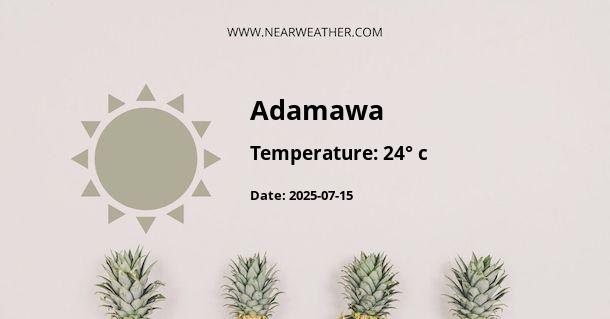Climate and Weather in Adamawa State, Nigeria
Adamawa State is located in northeastern Nigeria and is known for its diverse climate and unique weather patterns. The state experiences a combination of tropical and semi-arid climates, resulting in distinct seasons and temperature variations throughout the year.
Temperature
The average annual temperature in Adamawa State ranges from 24 to 32 degrees Celsius (75 to 90 degrees Fahrenheit). However, the temperature can fluctuate depending on the season and the specific location within the state.
During the dry season, which typically spans from November to March, temperatures can reach their peak, with daytime temperatures often exceeding 35 degrees Celsius (95 degrees Fahrenheit). The hottest months are usually March and April.
On the other hand, during the rainy season, which typically occurs from April to October, temperatures are generally cooler, ranging from 24 to 30 degrees Celsius (75 to 86 degrees Fahrenheit). The wettest months are usually August and September.
Rainfall
Rainfall in Adamawa State is highly variable throughout the year. The state experiences a bimodal rainfall pattern, with two distinct rainy seasons and two dry seasons.
The first rainy season, known as the "preliminary rains," occurs from March to May. During this period, the state receives moderate rainfall, with an average of 200 to 300 millimeters (8 to 12 inches) per month. These rains prepare the land for cultivation and farming activities.
The second rainy season, known as the "major rains," occurs from June to October. This period is characterized by heavy rainfall, with an average of 300 to 400 millimeters (12 to 16 inches) per month. These rains are essential for agricultural activities and the replenishment of water sources in the state.
The dry season in Adamawa State is divided into two periods. The first dry season, known as the "August break," occurs in August and is characterized by a brief pause in rainfall. The second dry season, known as the "harmattan season," occurs from November to February and is characterized by dry and dusty winds blowing from the Sahara Desert.
Humidity
Humidity levels in Adamawa State vary depending on the season. During the dry season, humidity levels are generally lower, ranging from 20% to 40%. This lower humidity, combined with high temperatures, can create a hot and arid climate.
During the rainy season, humidity levels tend to be higher, ranging from 60% to 90%. The increased moisture in the air during this period contributes to the lush vegetation and agricultural productivity in the state.
Wind Patterns
Adamawa State experiences different wind patterns depending on the season. During the dry season, there is a prevalence of dry and dusty winds, commonly known as the harmattan winds, blowing from the northeast.
These winds bring dry and dusty conditions and can reduce visibility. They also have a cooling effect on the temperature, providing some relief from the heat. However, they can also lead to dryness and pose challenges for agricultural activities.
During the rainy season, the wind patterns change, and the prevailing winds blow from the southwest. These moist winds bring in the much-needed rainfall and contribute to the overall climate and weather patterns in the state.
Impact on Agriculture
The climate and weather patterns in Adamawa State have a significant impact on agriculture, which is the mainstay of the state's economy. The rainfall during the rainy season provides water for irrigation and supports the growth of crops such as maize, millet, rice, and sorghum.
The dry season, although challenging for farming, allows for the cultivation of cash crops like cotton and groundnuts. The harmattan winds during this period also help in drying and preserving crops and other agricultural products.
However, the variability in rainfall and the occasional occurrence of droughts can pose challenges to agricultural productivity. Farmers in the state often rely on traditional methods of water conservation and irrigation to mitigate the effects of the climate on their crops.
Conclusion
Adamawa State experiences a diverse climate and weather patterns throughout the year. The state's location in northeastern Nigeria gives rise to tropical and semi-arid climates, resulting in distinct seasons, temperature variations, and rainfall patterns.
The temperature ranges from 24 to 32 degrees Celsius (75 to 90 degrees Fahrenheit) annually, with the dry season being hotter than the rainy season. Rainfall is variable, with two distinct rainy seasons and two dry seasons, and plays a crucial role in agricultural activities in the state.
Understanding the climate and weather patterns in Adamawa State is essential for farmers, residents, and policymakers to make informed decisions about agriculture, water management, and other aspects of daily life in the state.
A - Adamawa's Latitude is 9.333330 & Longitude is 12.500000.
A - Weather in Adamawa is 29° today.
A - Climate Conditions in Adamawa shows broken clouds today.
A - Humidity in Adamawa is 11% today.
A - Wind speed in Adamawa is 2.02 km/h, flowing at 19° wind direction. today.
